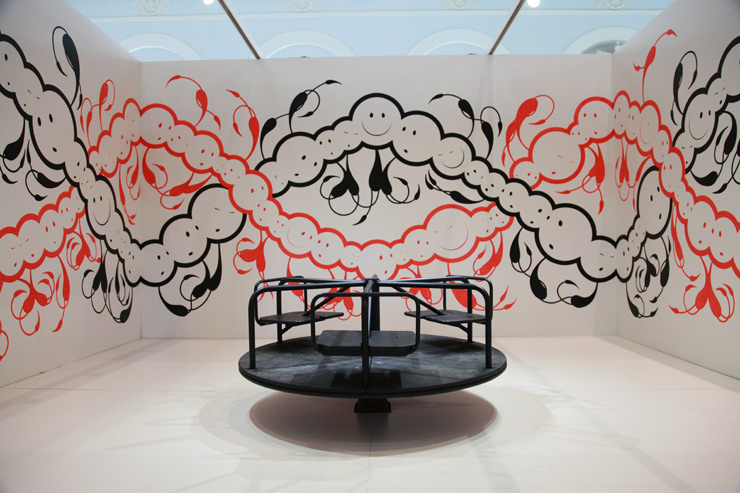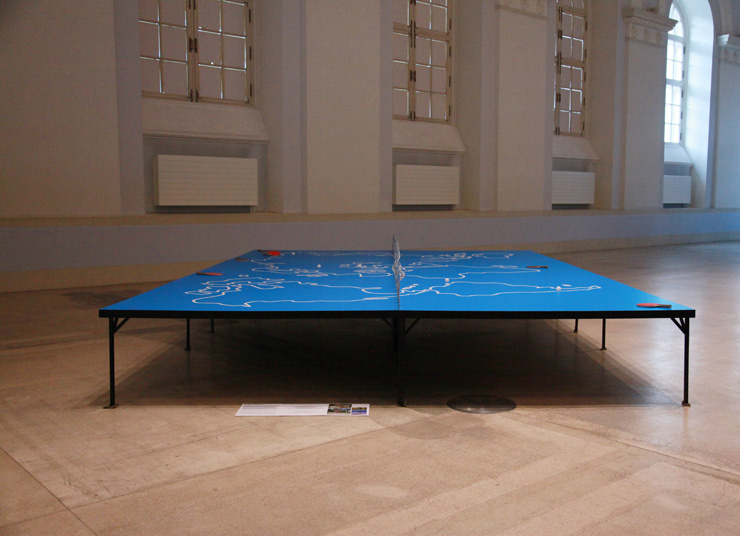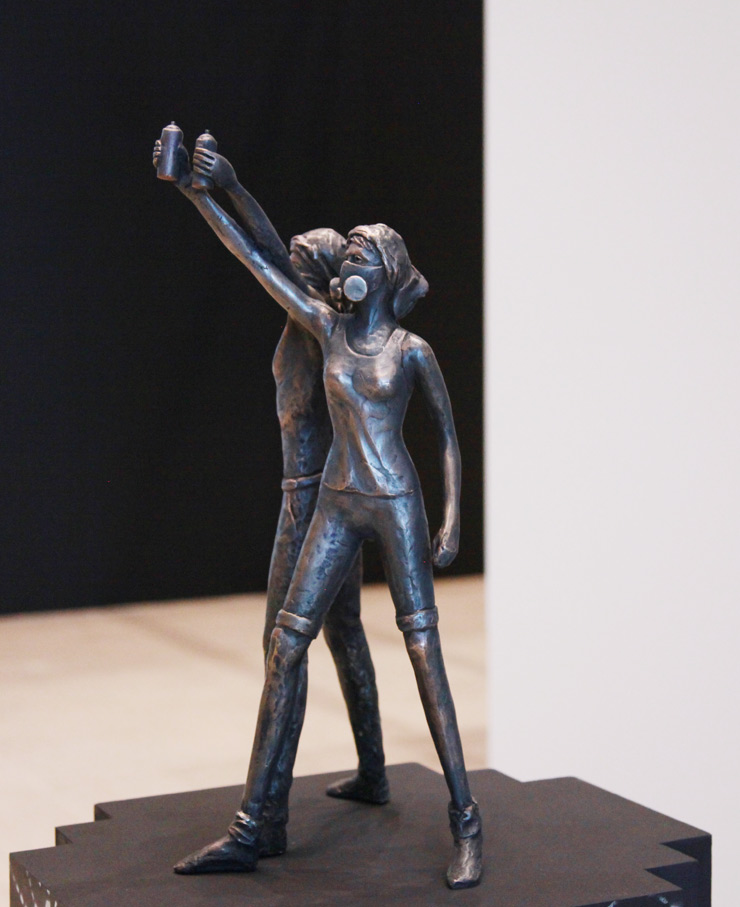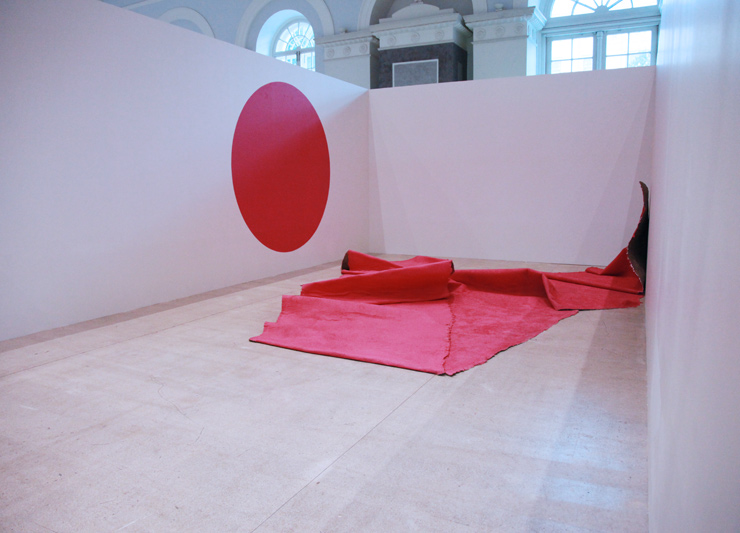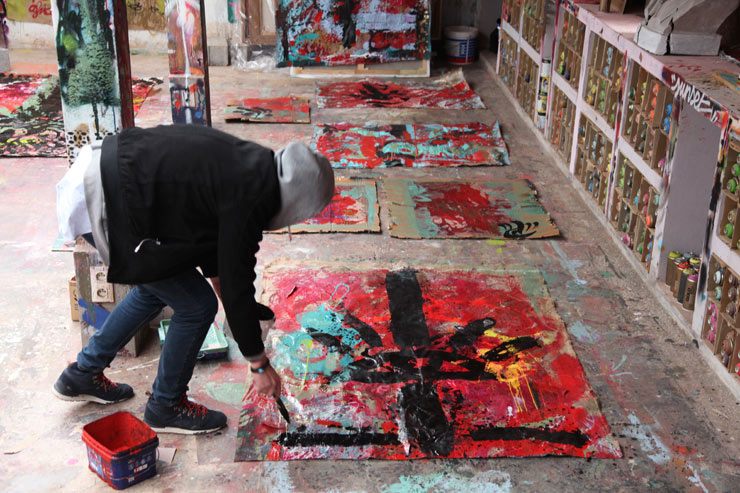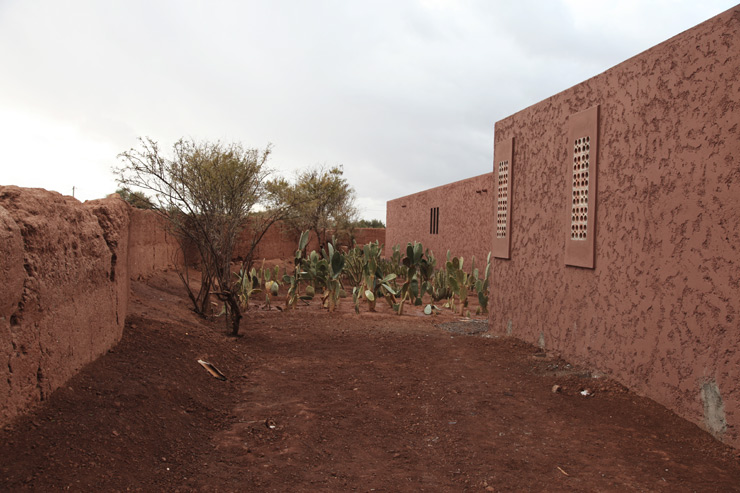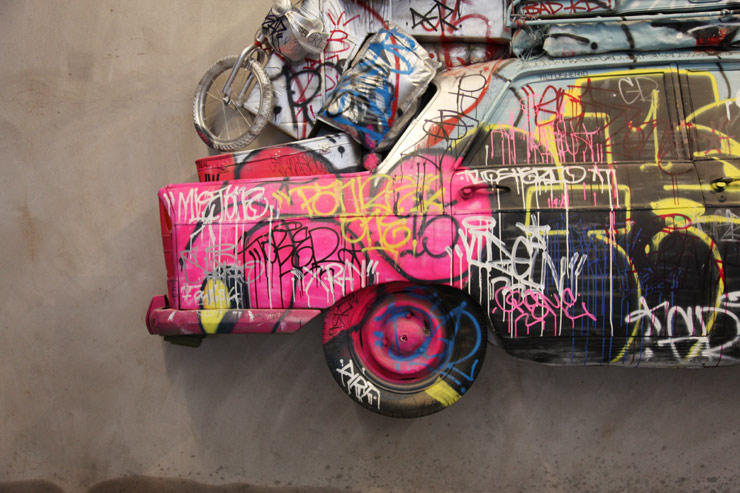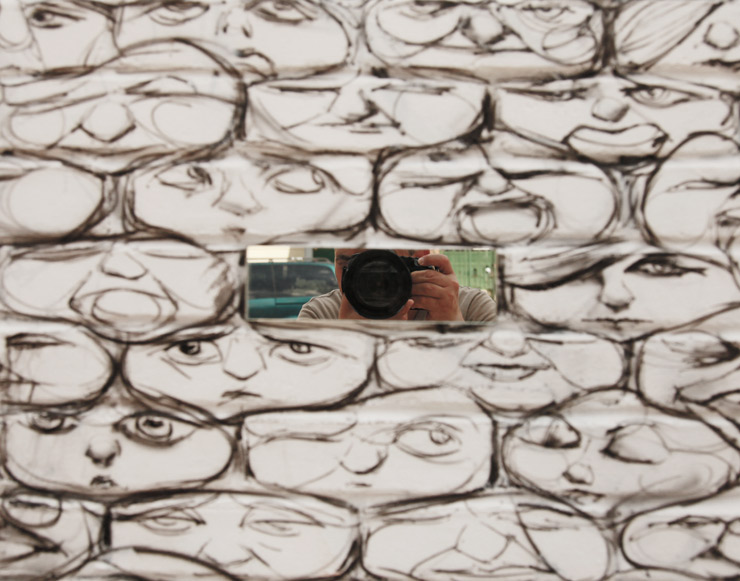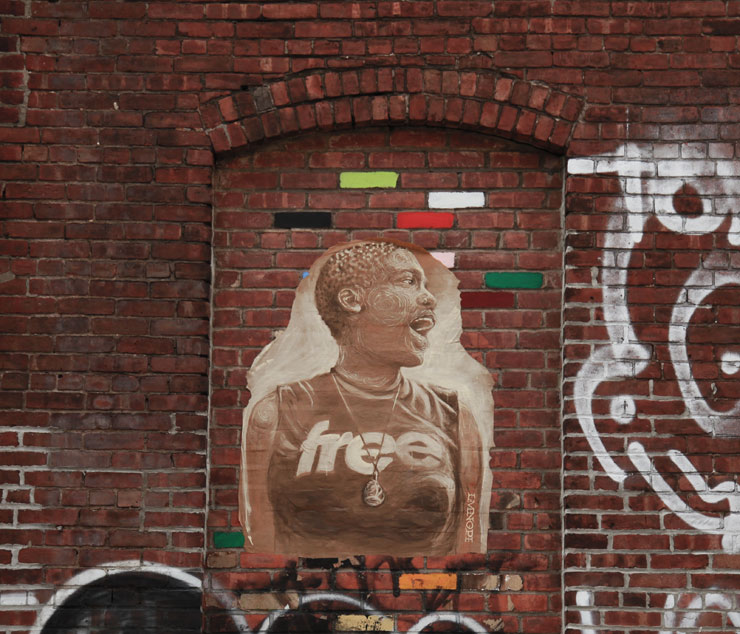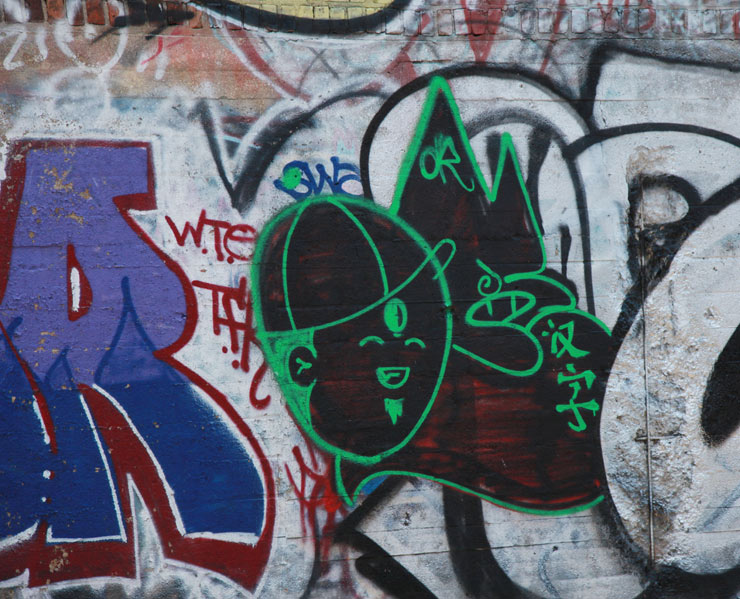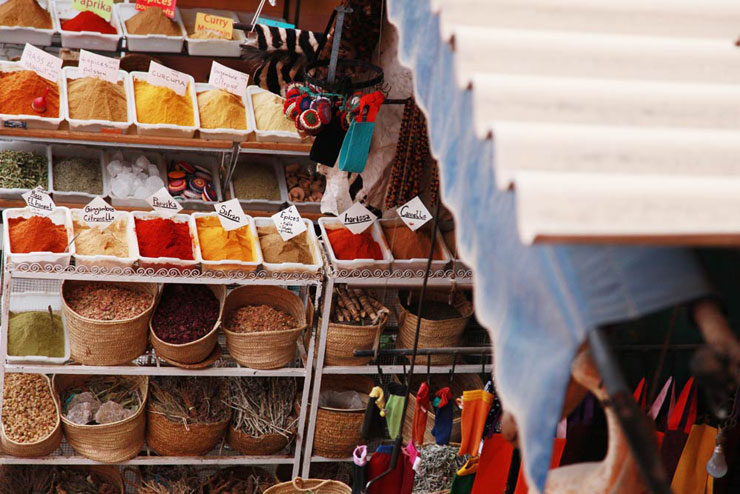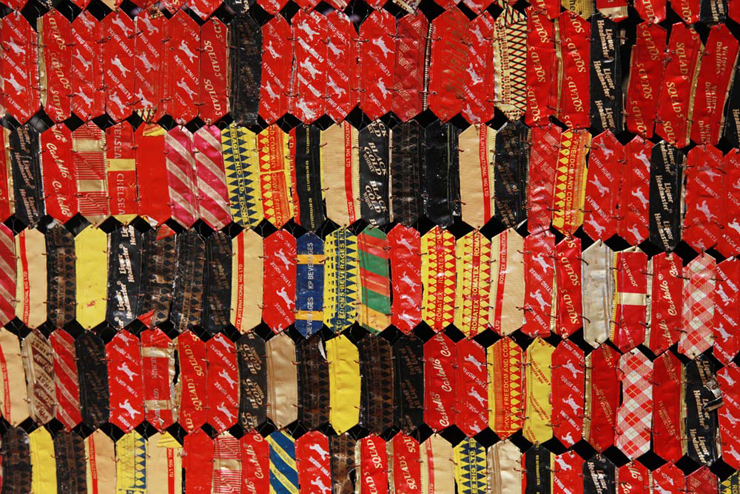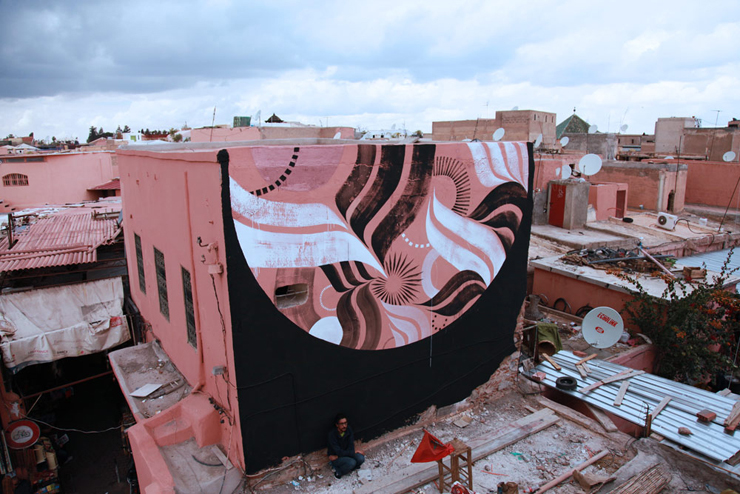The Moscow Manege Hosts International and Local Street Artists for a Biennale
Moscow presents a Street Artist’s exhibition, but the streets have almost none.
When Street Art and it’s associated cousins move inside the possible outcomes are many. With exhibitions like this you are seeing urban becoming very contemporary.
Belgian artist SozyOne at Artmossphere Biennale 2016, Moscow. photo © Jaime Rojo
The Artmossphere Biennale jump-starts the debate for many about how to best present the work of Street Artists and organizers here in Moscow chose a broad selection of curators from across a spectrum of private, commercial, academic and civically-inspired perspectives to present a solid range of artists from the graffiti and Street Art world inside a formal hall.
To be clear, unless it is illegal and on the street, it is not graffiti nor Street Art. That is the prevailing opinion about these terms among experts and scholars of various stripes and it is one we’re comfortable with. But then there are the commercial and cultural influences of the art world and the design industries, with their power to reshape and loosen terms from their moorings. Probably because these associated art movements are happening and taking shape before our eyes and not ensconced in centuries of scholarship we can expect that we will continue to witness the morphing our language and terminologies, sometimes changing things in translation.
A working carousel provides wildly waving optics for riders in this room by The London Police at the Artmossphere Biennale 2016, Moscow. photo © Jaime Rojo
Definitions aside, when you think of more organic Street Art scenes which are always re-generating themselves in the run-down abandoned sectors of cities like Sao Paulo, New York, Melbourne, Paris, Mexico City, London, and Berlin, it is interesting to consider that this event takes place nearly on the grounds of the Kremlin under museum like security.
An international capital that ensures cleanly buffed walls within hours of the appearance of any unapproved Street Art or graffiti, Moscow also boasts a growing contingent of art collectors who are young enough to appreciate the cultural currency of this continuously mutating hybrid of graffiti, hip hop, DIY, muralism, and art-school headiness. The night clubs and fashionable kids here are fans of events like hip-hop and graffiti jams, sometimes presented as theater and other times as “learning workshops” and the like.
Madrid-based Paris born artist Remed at the Artmossphere Biennale 2016, Moscow. photo © Jaime Rojo
Plugging into this idea of street and youth culture is not a singular fascination – there is perhaps an association with the rebellious anti-authoritarian nature of unregulated art in the streets that fuels the interest of many. With graffiti and hip-hop culture adoption as a template, newer expressions of Street Art culture are attractive as well with high profile artists with rebel reputations are as familiar in name here as in many cities. New festivals and events sometimes leverage this renegade free-spirit currency for selling tourism and brands and real estate, but here there also appears to be an acute appreciation for its fine art expression – urban contemporary art.
MOSCOW’S MANEGE AND “DEGENERATE ART”
So ardent is the support for Artmossphere here that a combination of public and private endorsements and financial backing have brought it to be showcased in a place associated with high-culture and counter-culture known as the Moscow Manege (Мане́ж). The location somehow fits the rebellious spirit that launched these artists even if its appearance wouldn’t lead you to think that.
The 19th century neo-classical exhibition hall stands grandly adjacent to Red Square and was built as an indoor riding school large enough to house a battalion of 2,000 soldiers during the 1800s. It later became host to many art exhibitions in the 20th century including a famous avant-garde show in 1962 that Soviet Premier Nikita Khrushchev famously derided as displaying ‘degenerate’ art.
Polish painter Sepe says his wall speaks to those who would pull the strings behind the scenes. He finished it within three days at the Artmossphere Biennale 2016, Moscow. photo © Jaime Rojo
One of the artists whose work was criticized, painter and sculptor Ernst Neizvestny, challenged the label defiantly and won accolades afterward during his five decade career that followed, including receiving many awards and his work being collected worldwide by museums. Russian President Vladimir Putin is quoted as calling him “a recognised master and one of the best contemporary sculptors”. In January of this year at the age of 90, Neizvestny’s return to Menage featured an extensive exhibition. He passed away August 9th (The Moscow Times), only weeks before Artmossphere opened.
In some kindred spirit many of these artists at Artmossphere have done actual illegal work on the streets around the world during their respective creative evolutions, and graffiti and Street Art as a practice have both at various times been demonized, derided, dismissed and labeled by critics in terms synonymous with “degenerate”.
A CLEAN CITY
“Moscow is mostly very clean,” says Artmossphere co-founder and Creative Director Sabine Chagina, who walks with guests during a sunny afternoon in a busy downtown area just after the opening. “But we do have some good graffiti crews,” she says as we round the corner from the famous Bolshoi Theater and soon pass Givenchy and Chanel and high-end luxury fashion stores. Shortly we see a mural nearby by French artist Nelio, who painted a lateral abstracted geometric, possibly cubist, piece on the side of a building here in 2013 as part of the LGZ Festival.
Barcelona based Miss Van had one of her paintings translated into a woven wool rug with artisans in Siberia. Here is a detail at the Artmossphere Biennale 2016, Moscow. photo © Jaime Rojo.
Miss Van at the Artmossphere Biennale 2016, Moscow. photo © Jaime Rojo
If there was graffiti here in Moscow, it was not on full display very readily in this part of town. In driving tours, rides on the extensive metro train system, and in street hikes across the city a visitor may find that much of the illegal street art and graffiti common to other global capitals is illusive due to a general distaste for it and a dedicated adherence to buffing it out quickly.
For a pedestrian tourist Moscow appears in many ways as fully contemporary and architecturally rich as any international world-class metropolis. One of the cleanest places you’ll visit, the metro is almost museum-like in some instances; the historic districts spotless, public fountains, famed statues of important historical figures. All is efficiently ordered and – a welcome surprise – most public space is free of advertisements interrupting your view and your thoughts.
Chile-born, Berlin-based artist and sculptor Pablo Benzo curated by The Art Union at the Artmossphere Biennale 2016, Moscow. photo © Jaime Rojo
Come to think of it, the sense of commercial-celebrity media saturation that is present in other cities doesn’t appear to permeate the artists psyche here at the Biennale – so there’s not much of the ironic Disney-Marilyn-supermodel-Kardashian-skewering of consumerism and shallowness in this exhibition that you may find in other Urban Art events.
Also, unlike a Street Art-splattered show in London for example that may rudely mock Queen Elizabeth or art in New York streets that present Donald Trump styled as a pile of poo and Hillary Clinton as Heath Ledger’s Joker, we didn’t see over-the-top Putin satires either. So personality politics don’t seem directly addressed in this milieu. According to some residents there was an outcropping of huge festival murals by Street Artists here just a few years ago but more recently they have been painted over with patriotic or other inspiring murals, while others have been claimed for commercial interests.
Brazilian Claudio Ethos at Artmossphere 2016. photo © Jaime Rojo
A REAL LIVE MURAL FROM L’ATLAS
Starved for some gritty street scenes, it is all the more interesting to see the one live mural painting that we were able to catch – a 6-story red-lined op-art tag by the French graffiti writer L’Atlas. Far from Manege, placed opposite a cineplex in what appears to be a shopping mall situated far from the city’s historical and modern centers, our guide tells us half-jokingly that he is not sure that we are still in Moscow.
L’Atlas on a Moscow wall for Artmossphere 2016. photo © Jaime Rojo
Here L’Atlas says that he has painted his bar-code-like and cryptic nom-de-plume with an assistant on a cherry picker for a few days and he says that no one has stopped to ask him about it, neither to comment or criticize. Actually one man early one morning returning home from a disco did engage him briefly, but it was difficult to tell what he was talking about as he may have had a few drinks.
This lack of public commentary is mainly notable because in other cities the comments from passersby can be so ubiquitous that artists deliberately wear stereo headphones to prevent interruption and to be more productive. Sometimes the headphones are not actually playing music.
The inside installation by L’Atlas for Artmossphere features multiple abstract iterations of his tag in day glo. photo © Jaime Rojo
WALKING THROUGH THE OPENING
This Street Art Biennale nonetheless is gaining a higher profile among Urban Art collectors and its associated art dealers and the opening and later auction reaches directly to this audience. Included this year with the primary “Invisible Walls” exhibition are satellite events in association with local RuArts Gallery, Tsekh Belogo at Winzavod, and the Optika Pavilion (No. 64) at VDNKh.
The opening night event itself is wide and welcoming, a mostly youthful and populist affair with celebratory speeches and loosely organized group photos and an open bar. Added together with a press conference, a live DJ, virtual reality headsets, interactive artworks, major private business sponsors, government grants, ministers of culture, gallerists, and quirkily fashionable art fans, this is a polished presentation of a global culture that is filtered through the wide lense of the street.
Wes21 from Switzerland is a graffiti artist blending reality and fantasy in this lunar-like landscape for Artmossphere features multiple abstract iterations of his tag in day glo. photo © Jaime Rojo
Perhaps because the exhibition hall is a cavernous rectangle with exposed beams on the ceiling and many of the constructed white walls that mimic vendor booths, it has the air of an art fair. There are thankfully no salespeople pacing back and forth watching your level of interest. People tend to cluster before installations and talk, laugh, share a story, pose for a selfie.
INVISIBLE WALLS
Similar in theme to the multidisciplinary exhibit about borders and boundaries curated by Raphael Schacter this spring in St. Petersburg at the Street Art Museum, Artmossphere asked artists to think about and address the “invisible walls” in contemporary life and societies.
Domo Collective present “Fair Play III” an enormous world map functioning ping pong table with a triple razor wire fence right down the middle. “We play an unhealthy game in which nobody believed to be responsible.” At Artmossphere 2016 in Moscow. Photo ©Jaime Rojo
The theme seems very appropriately topical as geopolitical, trade-related, social, digital, and actual walls appear to be falling down rapidly today while the foundations of new ones are taking shape. Catalyzed perhaps by the concept and practices of so-called “globalization” – with its easy flow of capital and restricted flow of humans, we are all examining the walls that are shaping our lives.
With 60+ international artists working simultaneously throughout this massive hall, newly built walls are the imperative for displaying art, supporting it, dividing it. These are the visible ones. With so many players and countries represented here, one can only imagine that there are a number of invisible walls present as well.
Domo Collective at Artmossphere 2016 in Moscow. Photo ©Jaime Rojo
The theme has opened countless interpretations in flat and sculptural ways, often expressed in the vernacular of fine art with arguable nods to mid-20th century modernists, folk art, fantasy, representational art, abstract, conceptual, computer/digital art, and good old traditional graffiti tagging. Effectively it appears that when Street Art and graffiti artists pass the precipice into a multi-disciplinary exhibition such as this, one can reframe Urban/Street as important tributaries to contemporary art – but will they re-direct the flow or be subsumed within it?
The work often can be so far removed from street practice that you don’t recognize it as related.
Vitaly Sy created a visualization of “Fear” as the main causes of internal barriers. The pieces are built around a central axis with elements at right angle to one another, and the man’s head on a swivel. Artmossphere 2016 in Moscow. Photo ©Jaime Rojo
Aside from putting work up in contested public space without permission and under cover, an average visitor may not see a common thread. These works run aesthetic to the conceptual, painterly to the sculptural, pure joy and pure politics. But then, that is we began to see in the streets as well when the century turned to the 21st and art students in large numbers in cities like New York and London and Berlin skipped the gatekeepers, taking their art directly to the public.
Perhaps beneath the surface or just above it, there is a certain anarchistic defiance, a critique of social, economic, political issues, a healthy skepticism toward everyone and everything that reeks of hypocritical patriarchal power structures. Perhaps we’re just projecting.
Moscow Manege exterior opening night of Artmossphere 2016 in Moscow. Photo courtesy of and © Artmossphere
Looking over the 60+ list of names, it may be striking to some that very few are people of color, especially in view of the origins of the graffiti scene. Similarly, the percentage of women represented is quite small. We are familiar with this observation about Urban Art in general today, and this show mirrors the European and American scene primarily, with notable exceptions such as Instagrafite’s home-based Brazilian crew of 4 artists. As only one such sampling of a wide and dispersed scene, it is not perhaps fair to judge it by artists race, gender, or background, but while we speak of invisible walls it is worth keeping our eyes on as this “scene” is adopted into galleries, museums, and private collections.
Following are some of the artists on view at Artmossphere:
ASKE
Certainly Moscow native ASKE is gently mocking our mutated modern practices of communicating with his outsized blocked abstraction of a close couple riveted to their respective electronic devices, even unaware of one another.
Moscow Street Artist ASKE at Artmossphere 2016. photo © Jaime Rojo
NeSpoon
“Precariat” by Polish Street Artist NeSpoon at Artmossphere 2016 with Urban Nation photo © Jaime Rojo
Warsaw based NeSpoon creates a sculpture of another couple. Heroically presenting her vision of what she calls the iconic “Graffiti Writer” and “Street Art Girl”, they face the future with art instruments in hand ready to make their respective marks. She says her work is emblematic of a permanent financial insecurity for a generation she calls the “PRECARIAT”.
“Precariat” by Polish Street Artist NeSpoon at Artmossphere 2016 with Urban Nation photo © Jaime Rojo
“ ‘Precariat’ is the name of the new emerging social class,” says curator, organizer, and NeSpoon’s partner Marcin Rutkiewicz when talking about the piece during the press conference. “These are young people living without a predictable future, without good jobs, without social security. It’s a class in the making and probably these people don’t have any consciousness or global unity of interest. But they are the engines of protest for people all over the world – like Occupy Wall Street, Gezi Park in Turkey, or the Arab Spring.”
“Precariat” by Polish Street Artist NeSpoon at Artmossphere 2016 with Urban Nation photo © Jaime Rojo
The artist developed the sculpture specifically for this exhibition and planned it over the course of a year or so. Born of a social movement in Poland by the same name, the sculpture and its sticker campaign on the street represent “a kind of protest against building walls between people who are under the same economical and social situation all over the world,” says Rutkiewicz.
LI-HILL
Artist Li-Hill says his piece “Guns, Germs, and Steel” directly relates to the divisions between civilizations due to a completely uneven playing field perpetuated through generations. Inspired by the 1997 trans-disciplinary non-fiction book by Jared Diamond, Li-Hill says the Russian sculptural group called “The Horse Tamers” represents mankind’s “ability to harness power of the natural world and to be able to manipulate it for its advantage.”
“Guns, Germs, and Steel” by Li-Hill at Artmossphere 2016 with Urban Nation photo © Jaime Rojo
“The horse is one of the largest signifiers and is a catalyst for advancement in society because it has been for military use, for agriculture, for transportation,” he says. “It was the most versatile of the animals and the most powerful.” Here he painted a mirror image, balanced over a potential microbial disaster symbol, and he and the team are building a mirrored floor to “give it this kind of infinite emblem status.”
The artist Li-Hill inside his piece at Artmossphere 2016. photo © Jaime Rojo
M-CITY
Afloat in the middle of some of these walled areas M-City from Poland is choosing to be more direct thematically in his three dimensional installation of plywood, plaster, aerosol and bucket paint, and machine blown insulation.
“It is an anti-war piece,” he says, and he speaks about the walls between nations and a losing battle of dominance that ensures everyone will be victim.”
The artist M-City at Artmossphere 2016. photo © Jaime Rojo
“It’s kind of a monster who destroys arms,” he says of this temporary sculpture with a lording figure crushing tanks below.
“He is destroying the tanks but at the same time he is also a destroyer – so it’s a big circle. Nothing is positive that can come out of this. There is always someone bigger.” He says the piece is inspired by the political situations in Europe today and the world at large.
HOTTEA
Minneapolis based HOTTEA usually does very colorful yarn installations transforming a huge public space, but for Artmossphere he is taking the conceptual route. The walk-in room based on the Whack-A-Mole game presents holes which a visitor can walk under and rise above.
The artist Hot Tea at Artmossphere 2016. photo © Jaime Rojo
Visitors/participants will experience the physical separation of space, and perhaps contemplate facing one another and interacting or ignoring one another. It is something he says he hopes will draw attention to how many walls we have allowed ourselves to distract from human interactions.
SICK BOY
Climb over a wall to slide into Sick Boy’s “The Rewards System”. photo © Jaime Rojo
Englands’ Sick Boy calls his project The Rewards System, where guests are invited to climb a ladder over a brick wall and descend down a slide into a darkened house, setting off a series of sensors that activate a variety of multisensory lights and tantalizing patterns. After landing and being rewarded the visitor is forced to exit on hands and knees through a too-small square door.
A young visitor exits Sick Boy’s “The Rewards System”. photo © Jaime Rojo
“The concept of the show is about invisible walls so I was thinking about there being barriers in your life and I thought about the reward of endorphins one experiences for achieving a task – a small amount of endorphins. So I thought I would build a house that signifies the reward system,” he explains.
DEREK BRUNO
Temporary installations : Slab Fence PO-2. Derek Bruno. photo © Jaime Rojo
Atlanta/Seattle based Derek Bruno reached back to the Leonid Brezhnev years and into Moscow’s Gorky Park for his series of site specific installations based on Soviet Cement Fence type PO-2. The iconic fence was re-created in a nearby studio and Bruno shot photographs of his 10-15 minute “interventions” in the park itself, revisiting a field of design called “technical aesthetics.”
A photo on display for his installation from Derek Bruno “MOSCOW PO2 Escalator” for Artmossphere. Photo ©Derek Bruno
In a statement Bruno explains “Since the end of the Soviet Union, the iconic fence has become a persistent and ever present reminder of former delineations of space; while new forms of boundaries shape the digital and sociopolitical landscapes. “
REMI ROUGH
Remi Rough is known for his smartly soaring abstract geometry in painted murals and smaller scale works, and for Moscow he wanted to strip it back to the basics, approaching a white box with one undulating graphic composition.
“My idea was that Moscow’s a bit ‘over the top’,” he says, and he decided to strip back the audacity and go for simplicity, which actually takes courage.
Remi Rough, “Fold”. photo © Jaime Rojo
“I said ‘you know what?’ – I want to do something with the cheapest materials you can possibly get. These two pieces literally cost 3000 rubles ($50). It’s made of felt, it’s like a lambs wool. I think they use it for flooring for construction.” Depending on the angle, the pink blotted material may translate as a swath of otherworldly terrain or a metaphorical bold vision with all the hot air let out.
“I wanted to do something peaceful and calming and use natural materials – something that’s different from what I usually do – but I use the folds in the fabric and the pink color – two things that I usually use a lot.”
ALEXEY LUKA
Moscow’s Alexey Luka is also challenging himself to stretch creatively by taking his wall collage installations of found wood and converting them into free-standing sculptures.
“For this biennale I tried to make something different so now I am going from the assemblages to 3-D.” The constructed media is warm and ordered, reserved but not without whimsy.
Alexey Luka at Artmossphere Biennale 2016 photo © Jaime Rojo
“My work is made from found wood – I use it with what I found on the street and my shapes and my graphics – so it’s kind of an experiment with three dimensions,” and he confirms that most of this wood is sourced here in Moscow.
We ask him about the number of eyes that peer out from his installation. Perhaps these eyes are those of Muscovites? “They are just like observers,” he says.
MIMMO RUBINO AKA RUB KANDY
Mimmo aka Rub Kandy at Artmossphere 2016. photo © Jaime Rojo
Torino’s Mimmo recreated the Moscow Olympic Village from the 1980 games in miniature presented as on a plainly brutalist platform. The sculpture is austere in detail on the hulking towers save for the tiny graffiti tags, throwies, rollers, extinguisher tags, and the like at the bases and on the roofs.
Curator Christian Omodeo tells us that Mimmo recreated the massive village based on his direct study of the site as it stands today; a housing project that has hundreds of families — and a hip-hop / graffiti scene as well.
Mimmo aka Rub Kandy at Artmossphere 2016. photo © Jaime Rojo
It is striking that the scale reduces the impact of the graffiti – yet when experienced at eye-level it retains a potency. Even so, by recasting the relationship between viewer and mark-making, this graffiti actually seems “cute” because of its relative size to the viewer.
BRAD DOWNEY
Brad Downey and Alexander Petrelli hi-jacked the opening of the Biennale by circulating within the exhibit as a gallery with artworks for sale. With Downey performing as a street-huckster pushing his own art products, Mr. Patrelli showcased new Downey photo collages and drawings inside his mobile “Overcoat Gallery”
Alexander Petrelli exhibits work by Brad Downey at Artmossphere 2016. photo © Jaime Rojo
A charming Moscow art star / gallerist / performance artist, Mr. Patrelli is also a perennial character at openings and events in the city, by one account having appeared at 460 or so events since 1992 with his flashing overcoat. The artworks also feature Patrelli, completing a self-referential meta cycle that continued to circle the guests at the exhibition.
International artists participating in the Artmossphere Biennale 2016 include: Akacorleone, Alex Senna, Brad Downey, Chu (Doma), Orilo (Doma), Claudio Ethos, Demsky, Christopher Derek Bruno, Filippo Minelli, Finok, Galo, Gola Hundun, Hot Tea, Jaz, Jessie and Katey, Johannes Mundinger, L’Atlas, LiHill, LX One, M-city, TC, Mario Mankey, Martha Cooper, Miss Van, Nespoon, Millo, Pablo Benzo, Pastel, Paulo Ito, Proembrion, Remed, Remi Rough, Rub Kandy, Run, Sepe, Sickboy, Smash 137, Sozyone Gonsales, SpY, The London Police, Trek Matthews, Wes 21.
This article is a result of a Brooklyn Street Art partnership with Urban Nation Museum For Urban Contemporary Art in Berlin and was originally published at Urban Nation Museum For Urban Contemporary Art
Please note: All content including images and text are © BrooklynStreetArt.com, unless otherwise noted. We like sharing BSA content for non-commercial purposes as long as you credit the photographer(s) and BSA, include a link to the original article URL and do not remove the photographer’s name from the .jpg file. Otherwise, please refrain from re-posting. Thanks!
 BROOKLYN STREET ART LOVES YOU MORE EVERY DAY
BROOKLYN STREET ART LOVES YOU MORE EVERY DAY
